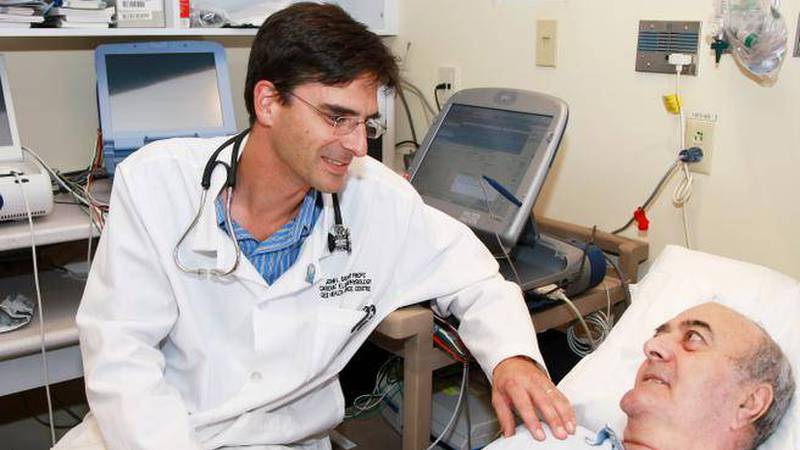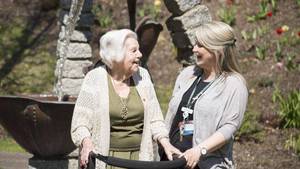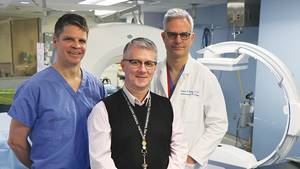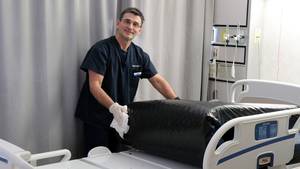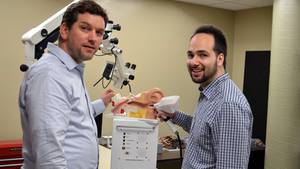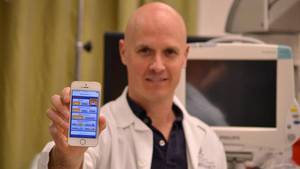Marc Arbour has always lived with heart disease. His family’s long history with the condition hit home when he had his first heart attack at the age of 34.
A subsequent angiogram – a procedure to see the heart’s blood vessels – revealed a complete blockage in his right artery and partial blockage in two others. In 1990, Marc was diagnosed with congestive heart failure; a condition that he knew “would only progress as time went on.” Despite this knowledge, a particularly harrowing event back in 2001 came as an unexpected shock.
“My heart started racing in an uncontrolled manner,” he recalls. “I lost consciousness when they were putting me in the ambulance. Afterwards, one of the paramedics said that they lost me twice during the resuscitation and they had to use the electrical paddles seven times to bring me back.”
“It shook me up,” he goes on to explain. “I thought that I was on a downward slippery slope which I had no control over.”
What followed was a series of invasive angiograms to help clear out the blockage, as well as the implantation of a defibrillator. He experienced several issues with the latter device due to the accumulation of scar tissue on his heart from previous episodes. By 2009, Marc was at a crossroads.
“One option was to take heavy medications,” he says. “But this wasn’t ideal for me because it would really affect the quality of my life.”
A QEII cardiac electrophysiologist named Dr. John Sapp gave Marc a bold but promising new alternative in the form of VANISH, a five-year study designed to determine the effectiveness of a procedure called catheter ablation.
“A heart attack leaves a scar in the heart muscle,” Dr. Sapp explains. “The heart is an electric organ, and so as the electric signals pass through it to tell it to beat, those scarred-up areas can cause cardiac arrest or ventricular tachycardia, a rapid heartbeat with multiple irregular beats. With catheter ablation we put a wire up in the heart, find where the scar is and try to cauterize the short circuits within it.”
Faced with the potentially diminishing effects of drug therapy, Marc opted to participate in this new study and within a few days he was slated for his procedure.
“The first procedure took approximately five hours,” he details. “I was semi-sedated but I remembered everything that was going on.”
Following the procedure, Marc immediately noticed that he “had more energy than I’d had for years previously.” And even though he was still getting spikes in his pulse, he no longer had sudden shocks, which he characterizes as a “godsend”.
Over the next two years, Marc was closely monitored by the clinical trial. During this time he continued to experience periodic bouts of unsustained ventricular tachycardia, or rising heart rhythms lasting under 30 seconds. To remedy this, Dr. Sapp proposed a second procedure designed to clear a new short circuit in his patient’s heart. Marc agreed and the results were nothing short of spectacular.
“I’m still getting the occasional little spike but I can’t even feel them. They’re virtually all gone. It’s absolutely amazing!” he says.
Even though catheter ablation “isn’t for everybody” and “there are lots of personal factors that might sway the decision” to employ this procedure, Dr. Sapp is encouraged by the results he’s seen so far.
“Compared to escalating drug therapy, catheter ablation reduced the risk of getting a shock or more than three episodes in a day or of death combined by 28 per cent.”
Dr. Sapp is quick to acknowledge that the VANISH study wouldn’t have been possible without the generosity of QEII Foundation donors, including a $1-million gift from Ralph and Shirlee Medjuck, in memory of their daughter Beth; along with supportive industry partners and a significant grant from the Canadian Institutes of Health Research.
“The impact of the Medjucks gift to the QEII Foundation was enormous and highly enabling,” Dr. Sapp says. “Because of them we’re able to have a state-of-the-art facility here for doing clinical procedures and that’s really enabled us to be at the leading-edge of therapy and investigation for this.”
For Marc Arbour, this level of philanthropy, combined with the visionary efforts of the VANISH study, couldn’t have come at a better time.
“To this day, I credit Dr. Sapp and his team for their outstanding performance during my care,” he says. “There was no pain or discomfort experienced during either of these surgeries and recovery times were absolutely minimal. It’s given me and my wife new hope for the future. Undoubtedly these procedures will help thousands of people.”

